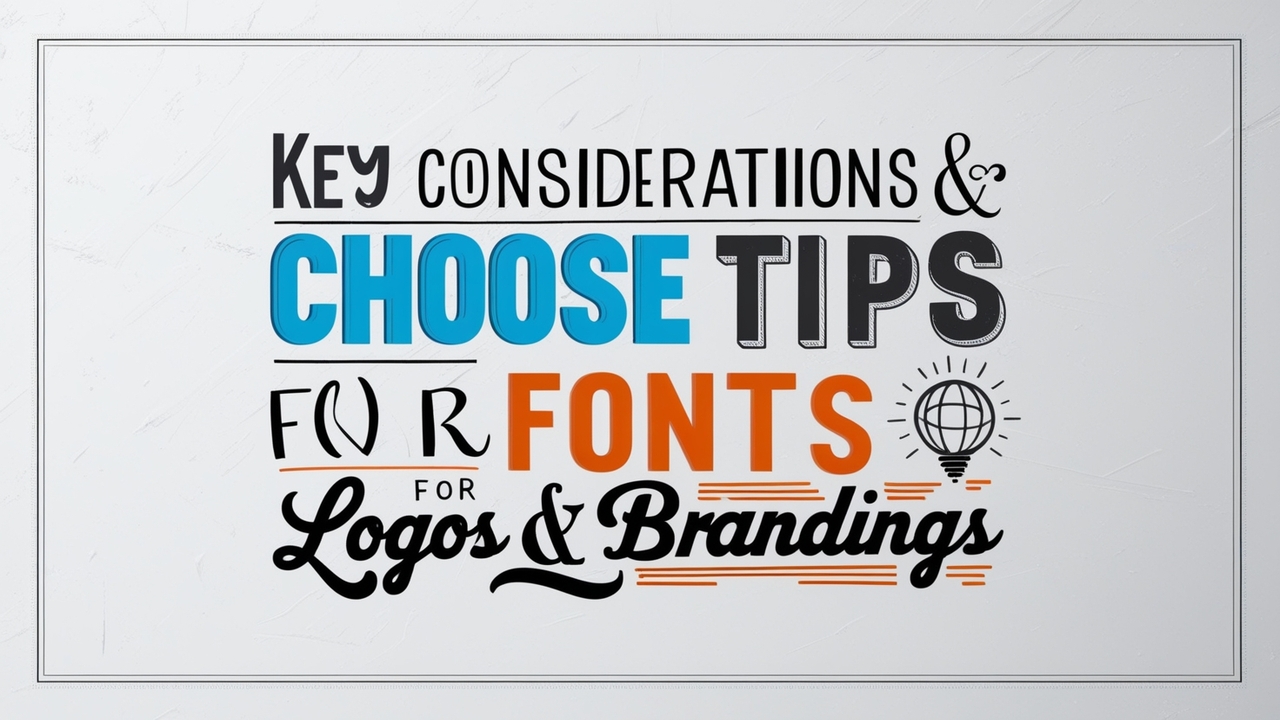Choosing the right font for your corporate identity and logos is a crucial step in establishing a strong brand presence. Fonts not only convey information but also express the personality of your brand. The font you choose can significantly impact how your business is perceived, making it essential to select carefully. Below are some key considerations and tips for choosing fonts that align with your brand identity.

Key Considerations And Tips To Choose Fonts For Logos & Brandings
Fonts are not just mere text elements; they carry the essence of your brand and can evoke specific emotions and perceptions among your audience. Fonts are not just mere text elements; they carry the essence of your brand and can evoke specific emotions and perceptions among your audience. Selecting the right typeface can enhance brand recognition and create a cohesive visual experience across all platforms.

Understand Your Brand Identity
Before selecting a logo font, it’s vital to have a clear understanding of your brand identity. Ask yourself questions about your brand’s personality: Is it playful or serious? Modern or traditional? This will guide your choice of typeface.
Explore Different Font Types
1.Serif Fonts:
These fonts have small lines at the ends of their characters, which can evoke a sense of tradition and reliability. Common examples include Times New Roman and Garamond. Serif logo fonts are ideal for businesses aiming for a classic or formal look.
2.Sans Serif Fonts:
These fonts lack the decorative lines of serif fonts and are generally more modern and clean. Open Sans and Helvetica are popular choices that convey simplicity and professionalism.
3.Script Fonts:
These fonts mimic handwriting and can add a personal touch to your logo. They are often used by brands looking to convey creativity or elegance. However, they should be used sparingly to maintain readability.
4.Display Fonts:
These are designed to stand out and grab attention. They work well in logos but may not be suitable for all types of branding. Use them carefully for maximum impact.
5.Custom Fonts:
Creating a custom font can help set your brand apart. This unique typeface can become synonymous with your brand identity, contributing to better brand recognition.
Consider Font Pairing
Font pairing is the art of combining different fonts in a single design. A good pairing can enhance the visual appeal of your branding. For instance, pairing a serif typeface for headings with a sans serif font for body text can create a harmonious look. Ensure that the fonts complement each other and convey a consistent message.
Emphasize Readability
While it might be tempting to choose the most stylish font, it’s essential to prioritize readability. Your business logo should be easily legible in various sizes. Fonts like Roboto and Proxima Nova are known for their excellent readability, making them great choices for branding.
Focus On Brand Personality
Different fonts convey different emotions. Consider your brand personality when choosing a font. A tech company might prefer a modern trendy font, while a legal firm might opt for a more traditional professional font.
Use fonts that reflect the core values and tone of your brand. Carefully select and pair fonts, including a primary font that serves as a foundation for design. You can ensure that your brand stands out while authenticating with your audience. Your chosen font should ultimately be one that reflects your values and appeals to your customers.
Utilize Resources
Platforms like Google Fonts and Adobe Fonts offer a wide variety of free and premium fonts that you can experiment with. Tools like Adobe Illustrator can help you visualize how different fonts will look in your logo design. A well-thought-out font combination can create visual harmony and enhance the overall branding experience. Additionally, a custom font might provide a unique touch that differentiates your brand in a competitive landscape.
Test And Iterate
Once you’ve chosen a few options, test them out in various contexts. How do they look on your website, business cards, or social media graphics? Make sure to consider the font style and how it aligns with your overall branding strategy. Don’t hesitate to iterate until you find the perfect font.
Conclusion
Incorporating different fonts, such as decorative fonts or a professional font, can help you convey the right message. Your goal should be to identify the best font or best logo font that resonates with your target audience and reflects your brand’s personality.
Choosing the right font for your corporate identity and logo is a blend of art and strategy. Understand your brand identity, explore different font types, and consider font pairing and readability.
You can select a font that enhances brand recognition and resonates with your target audience. With many options available— from slab serif fonts to elegant handwritten fonts—understanding how to choose fonts that align with your brand identity is essential.
FAQs
1.What Is The Best Font For Logo Design?
The best logo font depends on your brand identity. Serif fonts convey tradition, while sans serif fonts are more modern.
2.Can I Use Script Fonts In My Logo?
Yes, but use them sparingly to ensure readability. Script fonts work well for brands wanting a personal touch.
3.What Are The Advantages Of Custom Fonts?
Custom fonts can enhance brand recognition and set your brand apart from competitors.
4.How Can I Ensure My Logo Font Is Readable?
Choose fonts that are clear and legible at various sizes. Test them in different formats before finalizing.
5.What Resources Can I Use To Find Fonts?
Websites like Google Fonts and Adobe Fonts offer a wide selection of free and premium fonts for your branding needs.


Leave a Comment